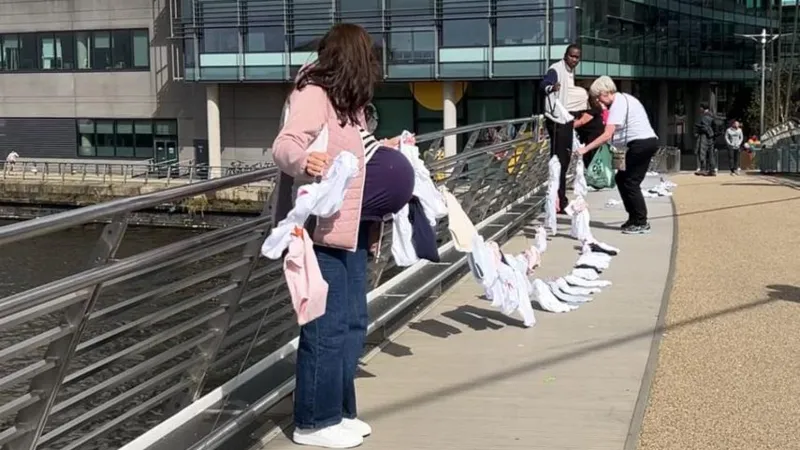In a poignant demonstration, a charity has hung baby vests on a bridge in Salford to draw attention to the fact that there are inadequate services for people affected by foetal alcohol spectrum disorder (FASD). The national organisation for FASD argues that many health authorities in England and Wales have failed to implement effective services to address this serious condition caused by alcohol consumption during pregnancy.
What is foetal alcohol spectrum disorder?
Foetal alcohol spectrum disorder is a range of conditions that can occur in individuals whose mothers drank alcohol during pregnancy. These conditions can lead to serious and lifelong problems, including problems with movement, vision, learning, emotional management and muscle and organ function. The disorder can be prevented, but once it occurs, it requires early intervention and ongoing support to manage.
The charity’s campaign
The national organisation for FASD has launched a high-profile campaign to promote better services and awareness. They placed baby vests on the side of a bridge at Media City in Salford as a clear visual reminder of the issue. The charity’s chief executive Sandra Butcher criticised NHS trusts for not following guidelines set out by the National Institute for Health and Care Excellence (NICE) in 2022. These guidelines were created to improve the management and treatment of FASD.
Government and NHS responses
The UK and Welsh governments have publicly committed to addressing FASD through education and preventative measures. However, the charity’s report highlights a lack of action on the part of many health authorities. In particular, the NHS Cheshire and Merseyside, NHS Lancashire and South Cumbria and NHS Greater Manchester integrated care boards have not introduced specific services for FASD, according to the charity.
However, the Greater Manchester board was acknowledged for its efforts to implement the NICE guidelines. Despite this, the charity argues that more needs to be done.
Call to action
The charity has made a number of recommendations to improve the situation:
Clear guidance: They are urging NHS England and Wales to provide clear guidance on how to implement NICE guidelines relating to FASD.
Appointment of FASD lead: They want NHS boards and trusts to appoint a dedicated FASD lead to oversee the development and delivery of services.
Funding: The charity is calling on the UK government to allocate a small portion of alcohol duty revenue to create a new FASD prevention fund.
Sandra Butcher emphasised the urgency of these measures, saying many individuals suffering from FASD are currently undiagnosed and not receiving the support they need, which can lead to tragic consequences.
Government commitments
In response to the charity’s concerns, a spokeswoman for the Department of Health and Social Care said the government is dedicated to reducing the incidence of FASD. The NHS plans to prioritise preventive public health measures, including efforts to reduce alcohol-related harm. This includes promoting the “no alcohol, no risk” message during pregnancy to protect babies.
A Welsh Government spokesperson also confirmed their commitment to the cause, saying all health boards actively promote the message of abstaining from alcohol during pregnancy to ensure the safety of babies.
Challenges and future directions
Despite these commitments, challenges remain. The charity’s campaign highlights a systemic issue within the NHS in relation to the management of FASD. While some areas are making progress, inconsistency in service provision and a lack of dedicated resources remain major barriers.
The charity’s protest and recommendations aim to mobilise action and improve support for those affected by FASD. By drawing public and government attention to the issue, they hope to create a more consistent and effective approach to preventing and managing this disorder.
Conclusion
The issue of foetal alcohol spectrum disorder highlights a significant gap in health services which affects many families. The National Organisation for FASD’s protest is a powerful reminder of the need for continued and comprehensive support for those affected by this preventable condition. As the government and NHS work to address these concerns, ongoing advocacy and public awareness will be crucial in ensuring that all affected individuals receive the help they need.
